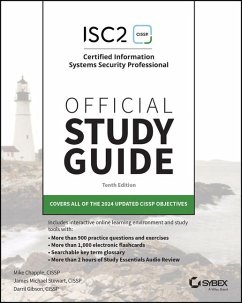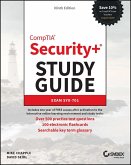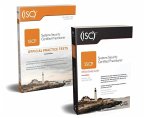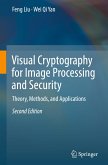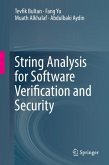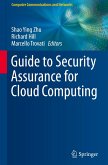Mike Chapple, James Michael Stewart, Darril Gibson
(ISC)2 CISSP Certified Information Systems Security Professional Official Study Guide
Mike Chapple, James Michael Stewart, Darril Gibson
(ISC)2 CISSP Certified Information Systems Security Professional Official Study Guide
- Broschiertes Buch
- Merkliste
- Auf die Merkliste
- Bewerten Bewerten
- Teilen
- Produkt teilen
- Produkterinnerung
- Produkterinnerung
Your Complete Guide to Preparing for the CISSP Certification, Updated for the CISSP 2024 Objectives The ISC2® CISSP® Certified Information Systems Security Professional Official Study Guide, 10th Edition is your one-stop resource for complete coverage of the 2024 CISSP objectives. You'll prepare for the exam smarter and faster with Sybex thanks to superior content including: an introductory assessment test that checks your readiness, objective map, written labs, key topic study essentials, and challenging chapter review questions. Reinforce what you have learned with the exclusive Sybex online…mehr
Andere Kunden interessierten sich auch für
![CompTIA Security+ Study Guide with over 500 Practice Test Questions CompTIA Security+ Study Guide with over 500 Practice Test Questions]() Mike ChappleCompTIA Security+ Study Guide with over 500 Practice Test Questions50,99 €
Mike ChappleCompTIA Security+ Study Guide with over 500 Practice Test Questions50,99 €![OCP Oracle Certified Professional Java SE 17 Developer Certification Kit OCP Oracle Certified Professional Java SE 17 Developer Certification Kit]() Jeanne BoyarskyOCP Oracle Certified Professional Java SE 17 Developer Certification Kit77,99 €
Jeanne BoyarskyOCP Oracle Certified Professional Java SE 17 Developer Certification Kit77,99 €![(ISC)2 SSCP Systems Security Certified Practitioner Official Study Guide & Practice Tests Bundle (ISC)2 SSCP Systems Security Certified Practitioner Official Study Guide & Practice Tests Bundle]() Mike Wills(ISC)2 SSCP Systems Security Certified Practitioner Official Study Guide & Practice Tests Bundle69,99 €
Mike Wills(ISC)2 SSCP Systems Security Certified Practitioner Official Study Guide & Practice Tests Bundle69,99 €![CompTIA Security+ Certification Kit CompTIA Security+ Certification Kit]() Mike ChappleCompTIA Security+ Certification Kit51,99 €
Mike ChappleCompTIA Security+ Certification Kit51,99 €![Visual Cryptography for Image Processing and Security Visual Cryptography for Image Processing and Security]() Feng LiuVisual Cryptography for Image Processing and Security39,99 €
Feng LiuVisual Cryptography for Image Processing and Security39,99 €![String Analysis for Software Verification and Security String Analysis for Software Verification and Security]() Tevfik BultanString Analysis for Software Verification and Security66,99 €
Tevfik BultanString Analysis for Software Verification and Security66,99 €![Guide to Security Assurance for Cloud Computing Guide to Security Assurance for Cloud Computing]() Guide to Security Assurance for Cloud Computing39,99 €
Guide to Security Assurance for Cloud Computing39,99 €-
-
-
Your Complete Guide to Preparing for the CISSP Certification, Updated for the CISSP 2024 Objectives The ISC2® CISSP® Certified Information Systems Security Professional Official Study Guide, 10th Edition is your one-stop resource for complete coverage of the 2024 CISSP objectives. You'll prepare for the exam smarter and faster with Sybex thanks to superior content including: an introductory assessment test that checks your readiness, objective map, written labs, key topic study essentials, and challenging chapter review questions. Reinforce what you have learned with the exclusive Sybex online learning environment and test bank. Get prepared to prove your CISSP knowledge with Sybex. Coverage of all CISSP Detailed Content Outline objectives in this Study Guide means you'll be ready for: * Security and Risk Management * Asset Security * Security Architecture and Engineering * Communication and Network Security * Identity and Access Management (IAM) * Security Assessment and Testing * Security Operations * Software Development Security Interactive learning environment: Take your certification prep to the next level with Sybex's superior interactive online study tools. To access our learning environment, simply visit www.wiley.com/go/sybextestprep, register to receive your unique PIN, and instantly gain one year of FREE access to: * Interactive test bank with four additional practice exams, each with 125 unique questions. Practice exams help you identify areas where further review is needed. * More than 2 hours of audio review read by author Mike Chapple. * More than 1,000 electronic flashcards to reinforce learning and last minute prep. * Comprehensive glossary in PDF format gives you instant access to the key terms so you are fully prepared ABOUT THE CISSP CERTIFICATION The CISSP is the most globally recognized certification in the information security market. This vendor neutral certification validates an information security professional's deep technical and managerial knowledge and experience to effectively design, engineer, and manage the overall security posture of an organization. ISC2 is a global nonprofit organization that maintains the Common Body of Knowledge for information security professionals. Candidates must have experience, subscribe to the ISC2 Code of Ethics, and maintain continuing education requirements or recertify every three years. Visit www.isc2.org to learn more.
Produktdetails
- Produktdetails
- Sybex Study Guide
- Verlag: Sybex / Wiley & Sons
- 10th ed.
- Seitenzahl: 1248
- Erscheinungstermin: 4. Juni 2024
- Englisch
- Abmessung: 234mm x 187mm x 49mm
- Gewicht: 1978g
- ISBN-13: 9781394254699
- ISBN-10: 1394254695
- Artikelnr.: 69306620
- Herstellerkennzeichnung
- Libri GmbH
- Europaallee 1
- 36244 Bad Hersfeld
- gpsr@libri.de
- Sybex Study Guide
- Verlag: Sybex / Wiley & Sons
- 10th ed.
- Seitenzahl: 1248
- Erscheinungstermin: 4. Juni 2024
- Englisch
- Abmessung: 234mm x 187mm x 49mm
- Gewicht: 1978g
- ISBN-13: 9781394254699
- ISBN-10: 1394254695
- Artikelnr.: 69306620
- Herstellerkennzeichnung
- Libri GmbH
- Europaallee 1
- 36244 Bad Hersfeld
- gpsr@libri.de
Mike Chapple, PhD, CISSP, CCSP, is a teaching professor of IT, analytics, and operations at the University of Notre Dame. He is a cybersecurity professional and educator with over 25 years experience including as chief information officer of Brand Institute and an information security researcher with the National Security Agency and the U.S. Air Force. Mike is the author of more than 200 books and video courses and provides cybersecurity certification resources at CertMike.com. James Michael Stewart, CISSP, has been writing and training for more than 25 years, with a focus on security. He has been teaching CISSP training courses since 2002, not to mention other courses on Internet security and ethical hacking/penetration testing. He is the author of and contributor to more than 80 books on security certification. Darril Gibson, CISSP, (1958-2022) was the CEO of YCDA, LLC and regularly wrote and consulted on a wide variety of technical and security topics and held numerous other security certifications. He authored or coauthored more than 30 books including multiple prior editions of the CISSP Study Guide.
Introduction xxxv Assessment Test lx Chapter 1 Security Governance Through Principles and Policies 1 Security 101 3 Understand and Apply Security Concepts 4 Security Boundaries 13 Evaluate and Apply Security Governance Principles 14 Manage the Security Function 16 Security Policy, Standards, Procedures, and Guidelines 27 Threat Modeling 29 Supply Chain Risk Management 35 Summary 38 Study Essentials 39 Written Lab 41 Review Questions 42 Chapter 2 Personnel Security and Risk Management Concepts 49 Personnel Security Policies and Procedures 51 Understand and Apply Risk Management Concepts 60 Social Engineering 90 Establish and Maintain a Security Awareness, Education, and Training Program 106 Summary 110 Study Essentials 111 Written Lab 114 Review Questions 115 Chapter 3 Business Continuity Planning 121 Planning for Business Continuity 122 Project Scope and Planning 123 Business Impact Analysis 131 Continuity Planning 137 Plan Approval and Implementation 140 Summary 145 Study Essentials 145 Written Lab 146 Review Questions 147 Chapter 4 Laws, Regulations, and Compliance 151 Categories of Laws 152 Laws 155 State Privacy Laws 179 Compliance 179 Contracting and Procurement 181 Summary 182 Study Essentials 182 Written Lab 184 Review Questions 185 Chapter 5 Protecting Security of Assets 189 Identifying and Classifying Information and Assets 190 Establishing Information and Asset Handling Requirements 198 Data Protection Methods 208 Understanding Data Roles 214 Using Security Baselines 216 Summary 219 Study Essentials 220 Written Lab 221 Review Questions 222 Chapter 6 Cryptography and Symmetric Key Algorithms 227 Cryptographic Foundations 228 Modern Cryptography 246 Symmetric Cryptography 253 Cryptographic Life Cycle 263 Summary 264 Study Essentials 264 Written Lab 266 Review Questions 267 Chapter 7 PKI and Cryptographic Applications 271 Asymmetric Cryptography 272 Hash Functions 279 Digital Signatures 283 Public Key Infrastructure 286 Asymmetric Key Management 292 Hybrid Cryptography 293 Applied Cryptography 294 Cryptographic Attacks 306 Summary 309 Study Essentials 310 Written Lab 311 Review Questions 312 Chapter 8 Principles of Security Models, Design, and Capabilities 317 Secure Design Principles 319 Techniques for Ensuring CIA 330 Understand the Fundamental Concepts of Security Models 332 Select Controls Based on Systems Security Requirements 345 Understand Security Capabilities of Information Systems 349 Summary 352 Study Essentials 353 Written Lab 354 Review Questions 355 Chapter 9 Security Vulnerabilities, Threats, and Countermeasures 359 Shared Responsibility 360 Data Localization and Data Sovereignty 362 Assess and Mitigate the Vulnerabilities of Security Architectures, Designs, and Solution Elements 363 Client
Based Systems 378 Server
Based Systems 381 Industrial Control Systems 384 Distributed Systems 386 High
Performance Computing (HPC) Systems 387 Real
Time Operating Systems 388 Internet of Things 389 Edge and Fog Computing 390 Embedded Devices and Cyber
Physical Systems 391 Microservices 396 Infrastructure as Code 397 Immutable Architecture 398 Virtualized Systems 399 Containerization 406 Mobile Devices 407 Essential Security Protection Mechanisms 424 Common Security Architecture Flaws and Issues 427 Summary 431 Study Essentials 432 Written Lab 436 Review Questions 437 Chapter 10 Physical Security Requirements 443 Apply Security Principles to Site and Facility Design 444 Implement Site and Facility Security Controls 449 Implement and Manage Physical Security 473 Summary 480 Study Essentials 481 Written Lab 484 Review Questions 485 Chapter 11 Secure Network Architecture and Components 491 OSI Model 493 TCP/IP Model 501 Analyzing Network Traffic 502 Common Application Layer Protocols 503 Transport Layer Protocols 504 Domain Name System 506 Internet Protocol (IP) Networking 512 ARP Concerns 516 Secure Communication Protocols 517 Implications of Multilayer Protocols 518 Segmentation 523 Edge Networks 526 Wireless Networks 527 Satellite Communications 543 Cellular Networks 544 Content Distribution Networks (CDNs) 544 Secure Network Components 545 Summary 572 Study Essentials 573 Written Lab 575 Review Questions 576 Chapter 12 Secure Communications and Network Attacks 581 Protocol Security Mechanisms 582 Secure Voice Communications 587 Remote Access Security Management 591 Multimedia Collaboration 595 Monitoring and Management 597 Load Balancing 597 Manage Email Security 600 Virtual Private Network 606 Switching and Virtual LANs 613 Network Address Translation 617 Third
Party Connectivity 622 Switching Technologies 624 WAN Technologies 626 Fiber
Optic Links 629 Prevent or Mitigate Network Attacks 630 Summary 631 Study Essentials 632 Written Lab 635 Review Questions 636 Chapter 13 Managing Identity and Authentication 641 Controlling Access to Assets 643 The AAA Model 645 Implementing Identity Management 662 Managing the Identity and Access Provisioning Life Cycle 668 Summary 672 Study Essentials 672 Written Lab 675 Review Questions 676 Chapter 14 Controlling and Monitoring Access 681 Comparing Access Control Models 682 Implementing Authentication Systems 694 ZeröTrust Access Policy Enforcement 702 Understanding Access Control Attacks 703 Summary 719 Study Essentials 720 Written Lab 721 Review Questions 722 Chapter 15 Security Assessment and Testing 727 Building a Security Assessment and Testing Program 729 Performing Vulnerability Assessments 735 Testing Your Software 750 Training and Exercises 758 Implementing Security Management Processes and Collecting Security Process Data 759 Summary 762 Exam Essentials 763 Written Lab 764 Review Questions 765 Chapter 16 Managing Security Operations 769 Apply Foundational Security Operations Concepts 771 Address Personnel Safety and Security 778 Provision Information and Assets Securely 780 Managed Services in the Cloud 786 Perform Configuration Management (CM) 790 Manage Change 793 Manage Patches and Reduce Vulnerabilities 797 Summary 801 Study Essentials 802 Written Lab 804 Review Questions 805 Chapter 17 Preventing and Responding to Incidents 809 Conducting Incident Management 811 Implementing Detection and Preventive Measures 818 Logging and Monitoring 842 Automating Incident Response 854 Summary 860 Study Essentials 860 Written Lab 863 Review Questions 864 Chapter 18 Disaster Recovery Planning 869 The Nature of Disaster 871 Understand System Resilience, High Availability, and Fault Tolerance 883 Recovery Strategy 888 Recovery Plan Development 898 Training, Awareness, and Documentation 906 Testing and Maintenance 907 Summary 911 Study Essentials 912 Written Lab 913 Review Questions 914 Chapter 19 Investigations and Ethics 919 Investigations 920 Major Categories of Computer Crime 934 Ethics 940 Summary 944 Study Essentials 945 Written Lab 946 Review Questions 947 Chapter 20 Software Development Security 951 Introducing Systems Development Controls 953 Establishing Databases and Data Warehousing 984 Storage Threats 994 Understanding Knowledge
Based Systems 995 Summary 998 Study Essentials 998 Written Lab 1000 Review Questions 1001 Chapter 21 Malicious Code and Application Attacks 1005 Malware 1006 Malware Prevention 1018 Application Attacks 1021 Injection Vulnerabilities 1024 Exploiting Authorization Vulnerabilities 1030 Exploiting Web Application Vulnerabilities 1033 Application Security Controls 1038 Secure Coding Practices 1044 Summary 1048 Study Essentials 1048 Written Lab 1049 Review Questions 1050 Appendix A Answers to Review Questions 1055 Chapter 1: Security Governance Through Principles and Policies 1056 Chapter 2: Personnel Security and Risk Management Concepts 1059 Chapter 3: Business Continuity Planning 1063 Chapter 4: Laws, Regulations, and Compliance 1065 Chapter 5: Protecting Security of Assets 1068 Chapter 6: Cryptography and Symmetric Key Algorithms 1070 Chapter 7: PKI and Cryptographic Applications 1072 Chapter 8: Principles of Security Models, Design, and Capabilities 1074 Chapter 9: Security Vulnerabilities, Threats, and Countermeasures 1077 Chapter 10: Physical Security Requirements 1082 Chapter 11: Secure Network Architecture and Components 1085 Chapter 12: Secure Communications and Network Attacks 1089 Chapter 13: Managing Identity and Authentication 1092 Chapter 14: Controlling and Monitoring Access 1095 Chapter 15: Security Assessment and Testing 1097 Chapter 16: Managing Security Operations 1099 Chapter 17: Preventing and Responding to Incidents 1102 Chapter 18: Disaster Recovery Planning 1104 Chapter 19: Investigations and Ethics 1106 Chapter 20: Software Development Security 1108 Chapter 21: Malicious Code and Application Attacks 1111 Appendix B Answers to Written Labs 1115 Chapter 1: Security Governance Through Principles and Policies 1116 Chapter 2: Personnel Security and Risk Management Concepts 1116 Chapter 3: Business Continuity Planning 1117 Chapter 4: Laws, Regulations, and Compliance 1118 Chapter 5: Protecting Security of Assets 1119 Chapter 6: Cryptography and Symmetric Key Algorithms 1119 Chapter 7: PKI and Cryptographic Applications 1120 Chapter 8: Principles of Security Models, Design, and Capabilities 1121 Chapter 9: Security Vulnerabilities, Threats, and Countermeasures 1121 Chapter 10: Physical Security Requirements 1123 Chapter 11: Secure Network Architecture and Components 1124 Chapter 12: Secure Communications and Network Attacks 1125 Chapter 13: Managing Identity and Authentication 1126 Chapter 14: Controlling and Monitoring Access 1127 Chapter 15: Security Assessment and Testing 1127 Chapter 16: Managing Security Operations 1128 Chapter 17: Preventing and Responding to Incidents 1129 Chapter 18: Disaster Recovery Planning 1130 Chapter 19: Investigations and Ethics 1131 Chapter 20: Software Development Security 1131 Chapter 21: Malicious Code and Application Attacks 1131 Index 1133
Based Systems 378 Server
Based Systems 381 Industrial Control Systems 384 Distributed Systems 386 High
Performance Computing (HPC) Systems 387 Real
Time Operating Systems 388 Internet of Things 389 Edge and Fog Computing 390 Embedded Devices and Cyber
Physical Systems 391 Microservices 396 Infrastructure as Code 397 Immutable Architecture 398 Virtualized Systems 399 Containerization 406 Mobile Devices 407 Essential Security Protection Mechanisms 424 Common Security Architecture Flaws and Issues 427 Summary 431 Study Essentials 432 Written Lab 436 Review Questions 437 Chapter 10 Physical Security Requirements 443 Apply Security Principles to Site and Facility Design 444 Implement Site and Facility Security Controls 449 Implement and Manage Physical Security 473 Summary 480 Study Essentials 481 Written Lab 484 Review Questions 485 Chapter 11 Secure Network Architecture and Components 491 OSI Model 493 TCP/IP Model 501 Analyzing Network Traffic 502 Common Application Layer Protocols 503 Transport Layer Protocols 504 Domain Name System 506 Internet Protocol (IP) Networking 512 ARP Concerns 516 Secure Communication Protocols 517 Implications of Multilayer Protocols 518 Segmentation 523 Edge Networks 526 Wireless Networks 527 Satellite Communications 543 Cellular Networks 544 Content Distribution Networks (CDNs) 544 Secure Network Components 545 Summary 572 Study Essentials 573 Written Lab 575 Review Questions 576 Chapter 12 Secure Communications and Network Attacks 581 Protocol Security Mechanisms 582 Secure Voice Communications 587 Remote Access Security Management 591 Multimedia Collaboration 595 Monitoring and Management 597 Load Balancing 597 Manage Email Security 600 Virtual Private Network 606 Switching and Virtual LANs 613 Network Address Translation 617 Third
Party Connectivity 622 Switching Technologies 624 WAN Technologies 626 Fiber
Optic Links 629 Prevent or Mitigate Network Attacks 630 Summary 631 Study Essentials 632 Written Lab 635 Review Questions 636 Chapter 13 Managing Identity and Authentication 641 Controlling Access to Assets 643 The AAA Model 645 Implementing Identity Management 662 Managing the Identity and Access Provisioning Life Cycle 668 Summary 672 Study Essentials 672 Written Lab 675 Review Questions 676 Chapter 14 Controlling and Monitoring Access 681 Comparing Access Control Models 682 Implementing Authentication Systems 694 ZeröTrust Access Policy Enforcement 702 Understanding Access Control Attacks 703 Summary 719 Study Essentials 720 Written Lab 721 Review Questions 722 Chapter 15 Security Assessment and Testing 727 Building a Security Assessment and Testing Program 729 Performing Vulnerability Assessments 735 Testing Your Software 750 Training and Exercises 758 Implementing Security Management Processes and Collecting Security Process Data 759 Summary 762 Exam Essentials 763 Written Lab 764 Review Questions 765 Chapter 16 Managing Security Operations 769 Apply Foundational Security Operations Concepts 771 Address Personnel Safety and Security 778 Provision Information and Assets Securely 780 Managed Services in the Cloud 786 Perform Configuration Management (CM) 790 Manage Change 793 Manage Patches and Reduce Vulnerabilities 797 Summary 801 Study Essentials 802 Written Lab 804 Review Questions 805 Chapter 17 Preventing and Responding to Incidents 809 Conducting Incident Management 811 Implementing Detection and Preventive Measures 818 Logging and Monitoring 842 Automating Incident Response 854 Summary 860 Study Essentials 860 Written Lab 863 Review Questions 864 Chapter 18 Disaster Recovery Planning 869 The Nature of Disaster 871 Understand System Resilience, High Availability, and Fault Tolerance 883 Recovery Strategy 888 Recovery Plan Development 898 Training, Awareness, and Documentation 906 Testing and Maintenance 907 Summary 911 Study Essentials 912 Written Lab 913 Review Questions 914 Chapter 19 Investigations and Ethics 919 Investigations 920 Major Categories of Computer Crime 934 Ethics 940 Summary 944 Study Essentials 945 Written Lab 946 Review Questions 947 Chapter 20 Software Development Security 951 Introducing Systems Development Controls 953 Establishing Databases and Data Warehousing 984 Storage Threats 994 Understanding Knowledge
Based Systems 995 Summary 998 Study Essentials 998 Written Lab 1000 Review Questions 1001 Chapter 21 Malicious Code and Application Attacks 1005 Malware 1006 Malware Prevention 1018 Application Attacks 1021 Injection Vulnerabilities 1024 Exploiting Authorization Vulnerabilities 1030 Exploiting Web Application Vulnerabilities 1033 Application Security Controls 1038 Secure Coding Practices 1044 Summary 1048 Study Essentials 1048 Written Lab 1049 Review Questions 1050 Appendix A Answers to Review Questions 1055 Chapter 1: Security Governance Through Principles and Policies 1056 Chapter 2: Personnel Security and Risk Management Concepts 1059 Chapter 3: Business Continuity Planning 1063 Chapter 4: Laws, Regulations, and Compliance 1065 Chapter 5: Protecting Security of Assets 1068 Chapter 6: Cryptography and Symmetric Key Algorithms 1070 Chapter 7: PKI and Cryptographic Applications 1072 Chapter 8: Principles of Security Models, Design, and Capabilities 1074 Chapter 9: Security Vulnerabilities, Threats, and Countermeasures 1077 Chapter 10: Physical Security Requirements 1082 Chapter 11: Secure Network Architecture and Components 1085 Chapter 12: Secure Communications and Network Attacks 1089 Chapter 13: Managing Identity and Authentication 1092 Chapter 14: Controlling and Monitoring Access 1095 Chapter 15: Security Assessment and Testing 1097 Chapter 16: Managing Security Operations 1099 Chapter 17: Preventing and Responding to Incidents 1102 Chapter 18: Disaster Recovery Planning 1104 Chapter 19: Investigations and Ethics 1106 Chapter 20: Software Development Security 1108 Chapter 21: Malicious Code and Application Attacks 1111 Appendix B Answers to Written Labs 1115 Chapter 1: Security Governance Through Principles and Policies 1116 Chapter 2: Personnel Security and Risk Management Concepts 1116 Chapter 3: Business Continuity Planning 1117 Chapter 4: Laws, Regulations, and Compliance 1118 Chapter 5: Protecting Security of Assets 1119 Chapter 6: Cryptography and Symmetric Key Algorithms 1119 Chapter 7: PKI and Cryptographic Applications 1120 Chapter 8: Principles of Security Models, Design, and Capabilities 1121 Chapter 9: Security Vulnerabilities, Threats, and Countermeasures 1121 Chapter 10: Physical Security Requirements 1123 Chapter 11: Secure Network Architecture and Components 1124 Chapter 12: Secure Communications and Network Attacks 1125 Chapter 13: Managing Identity and Authentication 1126 Chapter 14: Controlling and Monitoring Access 1127 Chapter 15: Security Assessment and Testing 1127 Chapter 16: Managing Security Operations 1128 Chapter 17: Preventing and Responding to Incidents 1129 Chapter 18: Disaster Recovery Planning 1130 Chapter 19: Investigations and Ethics 1131 Chapter 20: Software Development Security 1131 Chapter 21: Malicious Code and Application Attacks 1131 Index 1133
Introduction xxxv Assessment Test lx Chapter 1 Security Governance Through Principles and Policies 1 Security 101 3 Understand and Apply Security Concepts 4 Security Boundaries 13 Evaluate and Apply Security Governance Principles 14 Manage the Security Function 16 Security Policy, Standards, Procedures, and Guidelines 27 Threat Modeling 29 Supply Chain Risk Management 35 Summary 38 Study Essentials 39 Written Lab 41 Review Questions 42 Chapter 2 Personnel Security and Risk Management Concepts 49 Personnel Security Policies and Procedures 51 Understand and Apply Risk Management Concepts 60 Social Engineering 90 Establish and Maintain a Security Awareness, Education, and Training Program 106 Summary 110 Study Essentials 111 Written Lab 114 Review Questions 115 Chapter 3 Business Continuity Planning 121 Planning for Business Continuity 122 Project Scope and Planning 123 Business Impact Analysis 131 Continuity Planning 137 Plan Approval and Implementation 140 Summary 145 Study Essentials 145 Written Lab 146 Review Questions 147 Chapter 4 Laws, Regulations, and Compliance 151 Categories of Laws 152 Laws 155 State Privacy Laws 179 Compliance 179 Contracting and Procurement 181 Summary 182 Study Essentials 182 Written Lab 184 Review Questions 185 Chapter 5 Protecting Security of Assets 189 Identifying and Classifying Information and Assets 190 Establishing Information and Asset Handling Requirements 198 Data Protection Methods 208 Understanding Data Roles 214 Using Security Baselines 216 Summary 219 Study Essentials 220 Written Lab 221 Review Questions 222 Chapter 6 Cryptography and Symmetric Key Algorithms 227 Cryptographic Foundations 228 Modern Cryptography 246 Symmetric Cryptography 253 Cryptographic Life Cycle 263 Summary 264 Study Essentials 264 Written Lab 266 Review Questions 267 Chapter 7 PKI and Cryptographic Applications 271 Asymmetric Cryptography 272 Hash Functions 279 Digital Signatures 283 Public Key Infrastructure 286 Asymmetric Key Management 292 Hybrid Cryptography 293 Applied Cryptography 294 Cryptographic Attacks 306 Summary 309 Study Essentials 310 Written Lab 311 Review Questions 312 Chapter 8 Principles of Security Models, Design, and Capabilities 317 Secure Design Principles 319 Techniques for Ensuring CIA 330 Understand the Fundamental Concepts of Security Models 332 Select Controls Based on Systems Security Requirements 345 Understand Security Capabilities of Information Systems 349 Summary 352 Study Essentials 353 Written Lab 354 Review Questions 355 Chapter 9 Security Vulnerabilities, Threats, and Countermeasures 359 Shared Responsibility 360 Data Localization and Data Sovereignty 362 Assess and Mitigate the Vulnerabilities of Security Architectures, Designs, and Solution Elements 363 Client
Based Systems 378 Server
Based Systems 381 Industrial Control Systems 384 Distributed Systems 386 High
Performance Computing (HPC) Systems 387 Real
Time Operating Systems 388 Internet of Things 389 Edge and Fog Computing 390 Embedded Devices and Cyber
Physical Systems 391 Microservices 396 Infrastructure as Code 397 Immutable Architecture 398 Virtualized Systems 399 Containerization 406 Mobile Devices 407 Essential Security Protection Mechanisms 424 Common Security Architecture Flaws and Issues 427 Summary 431 Study Essentials 432 Written Lab 436 Review Questions 437 Chapter 10 Physical Security Requirements 443 Apply Security Principles to Site and Facility Design 444 Implement Site and Facility Security Controls 449 Implement and Manage Physical Security 473 Summary 480 Study Essentials 481 Written Lab 484 Review Questions 485 Chapter 11 Secure Network Architecture and Components 491 OSI Model 493 TCP/IP Model 501 Analyzing Network Traffic 502 Common Application Layer Protocols 503 Transport Layer Protocols 504 Domain Name System 506 Internet Protocol (IP) Networking 512 ARP Concerns 516 Secure Communication Protocols 517 Implications of Multilayer Protocols 518 Segmentation 523 Edge Networks 526 Wireless Networks 527 Satellite Communications 543 Cellular Networks 544 Content Distribution Networks (CDNs) 544 Secure Network Components 545 Summary 572 Study Essentials 573 Written Lab 575 Review Questions 576 Chapter 12 Secure Communications and Network Attacks 581 Protocol Security Mechanisms 582 Secure Voice Communications 587 Remote Access Security Management 591 Multimedia Collaboration 595 Monitoring and Management 597 Load Balancing 597 Manage Email Security 600 Virtual Private Network 606 Switching and Virtual LANs 613 Network Address Translation 617 Third
Party Connectivity 622 Switching Technologies 624 WAN Technologies 626 Fiber
Optic Links 629 Prevent or Mitigate Network Attacks 630 Summary 631 Study Essentials 632 Written Lab 635 Review Questions 636 Chapter 13 Managing Identity and Authentication 641 Controlling Access to Assets 643 The AAA Model 645 Implementing Identity Management 662 Managing the Identity and Access Provisioning Life Cycle 668 Summary 672 Study Essentials 672 Written Lab 675 Review Questions 676 Chapter 14 Controlling and Monitoring Access 681 Comparing Access Control Models 682 Implementing Authentication Systems 694 ZeröTrust Access Policy Enforcement 702 Understanding Access Control Attacks 703 Summary 719 Study Essentials 720 Written Lab 721 Review Questions 722 Chapter 15 Security Assessment and Testing 727 Building a Security Assessment and Testing Program 729 Performing Vulnerability Assessments 735 Testing Your Software 750 Training and Exercises 758 Implementing Security Management Processes and Collecting Security Process Data 759 Summary 762 Exam Essentials 763 Written Lab 764 Review Questions 765 Chapter 16 Managing Security Operations 769 Apply Foundational Security Operations Concepts 771 Address Personnel Safety and Security 778 Provision Information and Assets Securely 780 Managed Services in the Cloud 786 Perform Configuration Management (CM) 790 Manage Change 793 Manage Patches and Reduce Vulnerabilities 797 Summary 801 Study Essentials 802 Written Lab 804 Review Questions 805 Chapter 17 Preventing and Responding to Incidents 809 Conducting Incident Management 811 Implementing Detection and Preventive Measures 818 Logging and Monitoring 842 Automating Incident Response 854 Summary 860 Study Essentials 860 Written Lab 863 Review Questions 864 Chapter 18 Disaster Recovery Planning 869 The Nature of Disaster 871 Understand System Resilience, High Availability, and Fault Tolerance 883 Recovery Strategy 888 Recovery Plan Development 898 Training, Awareness, and Documentation 906 Testing and Maintenance 907 Summary 911 Study Essentials 912 Written Lab 913 Review Questions 914 Chapter 19 Investigations and Ethics 919 Investigations 920 Major Categories of Computer Crime 934 Ethics 940 Summary 944 Study Essentials 945 Written Lab 946 Review Questions 947 Chapter 20 Software Development Security 951 Introducing Systems Development Controls 953 Establishing Databases and Data Warehousing 984 Storage Threats 994 Understanding Knowledge
Based Systems 995 Summary 998 Study Essentials 998 Written Lab 1000 Review Questions 1001 Chapter 21 Malicious Code and Application Attacks 1005 Malware 1006 Malware Prevention 1018 Application Attacks 1021 Injection Vulnerabilities 1024 Exploiting Authorization Vulnerabilities 1030 Exploiting Web Application Vulnerabilities 1033 Application Security Controls 1038 Secure Coding Practices 1044 Summary 1048 Study Essentials 1048 Written Lab 1049 Review Questions 1050 Appendix A Answers to Review Questions 1055 Chapter 1: Security Governance Through Principles and Policies 1056 Chapter 2: Personnel Security and Risk Management Concepts 1059 Chapter 3: Business Continuity Planning 1063 Chapter 4: Laws, Regulations, and Compliance 1065 Chapter 5: Protecting Security of Assets 1068 Chapter 6: Cryptography and Symmetric Key Algorithms 1070 Chapter 7: PKI and Cryptographic Applications 1072 Chapter 8: Principles of Security Models, Design, and Capabilities 1074 Chapter 9: Security Vulnerabilities, Threats, and Countermeasures 1077 Chapter 10: Physical Security Requirements 1082 Chapter 11: Secure Network Architecture and Components 1085 Chapter 12: Secure Communications and Network Attacks 1089 Chapter 13: Managing Identity and Authentication 1092 Chapter 14: Controlling and Monitoring Access 1095 Chapter 15: Security Assessment and Testing 1097 Chapter 16: Managing Security Operations 1099 Chapter 17: Preventing and Responding to Incidents 1102 Chapter 18: Disaster Recovery Planning 1104 Chapter 19: Investigations and Ethics 1106 Chapter 20: Software Development Security 1108 Chapter 21: Malicious Code and Application Attacks 1111 Appendix B Answers to Written Labs 1115 Chapter 1: Security Governance Through Principles and Policies 1116 Chapter 2: Personnel Security and Risk Management Concepts 1116 Chapter 3: Business Continuity Planning 1117 Chapter 4: Laws, Regulations, and Compliance 1118 Chapter 5: Protecting Security of Assets 1119 Chapter 6: Cryptography and Symmetric Key Algorithms 1119 Chapter 7: PKI and Cryptographic Applications 1120 Chapter 8: Principles of Security Models, Design, and Capabilities 1121 Chapter 9: Security Vulnerabilities, Threats, and Countermeasures 1121 Chapter 10: Physical Security Requirements 1123 Chapter 11: Secure Network Architecture and Components 1124 Chapter 12: Secure Communications and Network Attacks 1125 Chapter 13: Managing Identity and Authentication 1126 Chapter 14: Controlling and Monitoring Access 1127 Chapter 15: Security Assessment and Testing 1127 Chapter 16: Managing Security Operations 1128 Chapter 17: Preventing and Responding to Incidents 1129 Chapter 18: Disaster Recovery Planning 1130 Chapter 19: Investigations and Ethics 1131 Chapter 20: Software Development Security 1131 Chapter 21: Malicious Code and Application Attacks 1131 Index 1133
Based Systems 378 Server
Based Systems 381 Industrial Control Systems 384 Distributed Systems 386 High
Performance Computing (HPC) Systems 387 Real
Time Operating Systems 388 Internet of Things 389 Edge and Fog Computing 390 Embedded Devices and Cyber
Physical Systems 391 Microservices 396 Infrastructure as Code 397 Immutable Architecture 398 Virtualized Systems 399 Containerization 406 Mobile Devices 407 Essential Security Protection Mechanisms 424 Common Security Architecture Flaws and Issues 427 Summary 431 Study Essentials 432 Written Lab 436 Review Questions 437 Chapter 10 Physical Security Requirements 443 Apply Security Principles to Site and Facility Design 444 Implement Site and Facility Security Controls 449 Implement and Manage Physical Security 473 Summary 480 Study Essentials 481 Written Lab 484 Review Questions 485 Chapter 11 Secure Network Architecture and Components 491 OSI Model 493 TCP/IP Model 501 Analyzing Network Traffic 502 Common Application Layer Protocols 503 Transport Layer Protocols 504 Domain Name System 506 Internet Protocol (IP) Networking 512 ARP Concerns 516 Secure Communication Protocols 517 Implications of Multilayer Protocols 518 Segmentation 523 Edge Networks 526 Wireless Networks 527 Satellite Communications 543 Cellular Networks 544 Content Distribution Networks (CDNs) 544 Secure Network Components 545 Summary 572 Study Essentials 573 Written Lab 575 Review Questions 576 Chapter 12 Secure Communications and Network Attacks 581 Protocol Security Mechanisms 582 Secure Voice Communications 587 Remote Access Security Management 591 Multimedia Collaboration 595 Monitoring and Management 597 Load Balancing 597 Manage Email Security 600 Virtual Private Network 606 Switching and Virtual LANs 613 Network Address Translation 617 Third
Party Connectivity 622 Switching Technologies 624 WAN Technologies 626 Fiber
Optic Links 629 Prevent or Mitigate Network Attacks 630 Summary 631 Study Essentials 632 Written Lab 635 Review Questions 636 Chapter 13 Managing Identity and Authentication 641 Controlling Access to Assets 643 The AAA Model 645 Implementing Identity Management 662 Managing the Identity and Access Provisioning Life Cycle 668 Summary 672 Study Essentials 672 Written Lab 675 Review Questions 676 Chapter 14 Controlling and Monitoring Access 681 Comparing Access Control Models 682 Implementing Authentication Systems 694 ZeröTrust Access Policy Enforcement 702 Understanding Access Control Attacks 703 Summary 719 Study Essentials 720 Written Lab 721 Review Questions 722 Chapter 15 Security Assessment and Testing 727 Building a Security Assessment and Testing Program 729 Performing Vulnerability Assessments 735 Testing Your Software 750 Training and Exercises 758 Implementing Security Management Processes and Collecting Security Process Data 759 Summary 762 Exam Essentials 763 Written Lab 764 Review Questions 765 Chapter 16 Managing Security Operations 769 Apply Foundational Security Operations Concepts 771 Address Personnel Safety and Security 778 Provision Information and Assets Securely 780 Managed Services in the Cloud 786 Perform Configuration Management (CM) 790 Manage Change 793 Manage Patches and Reduce Vulnerabilities 797 Summary 801 Study Essentials 802 Written Lab 804 Review Questions 805 Chapter 17 Preventing and Responding to Incidents 809 Conducting Incident Management 811 Implementing Detection and Preventive Measures 818 Logging and Monitoring 842 Automating Incident Response 854 Summary 860 Study Essentials 860 Written Lab 863 Review Questions 864 Chapter 18 Disaster Recovery Planning 869 The Nature of Disaster 871 Understand System Resilience, High Availability, and Fault Tolerance 883 Recovery Strategy 888 Recovery Plan Development 898 Training, Awareness, and Documentation 906 Testing and Maintenance 907 Summary 911 Study Essentials 912 Written Lab 913 Review Questions 914 Chapter 19 Investigations and Ethics 919 Investigations 920 Major Categories of Computer Crime 934 Ethics 940 Summary 944 Study Essentials 945 Written Lab 946 Review Questions 947 Chapter 20 Software Development Security 951 Introducing Systems Development Controls 953 Establishing Databases and Data Warehousing 984 Storage Threats 994 Understanding Knowledge
Based Systems 995 Summary 998 Study Essentials 998 Written Lab 1000 Review Questions 1001 Chapter 21 Malicious Code and Application Attacks 1005 Malware 1006 Malware Prevention 1018 Application Attacks 1021 Injection Vulnerabilities 1024 Exploiting Authorization Vulnerabilities 1030 Exploiting Web Application Vulnerabilities 1033 Application Security Controls 1038 Secure Coding Practices 1044 Summary 1048 Study Essentials 1048 Written Lab 1049 Review Questions 1050 Appendix A Answers to Review Questions 1055 Chapter 1: Security Governance Through Principles and Policies 1056 Chapter 2: Personnel Security and Risk Management Concepts 1059 Chapter 3: Business Continuity Planning 1063 Chapter 4: Laws, Regulations, and Compliance 1065 Chapter 5: Protecting Security of Assets 1068 Chapter 6: Cryptography and Symmetric Key Algorithms 1070 Chapter 7: PKI and Cryptographic Applications 1072 Chapter 8: Principles of Security Models, Design, and Capabilities 1074 Chapter 9: Security Vulnerabilities, Threats, and Countermeasures 1077 Chapter 10: Physical Security Requirements 1082 Chapter 11: Secure Network Architecture and Components 1085 Chapter 12: Secure Communications and Network Attacks 1089 Chapter 13: Managing Identity and Authentication 1092 Chapter 14: Controlling and Monitoring Access 1095 Chapter 15: Security Assessment and Testing 1097 Chapter 16: Managing Security Operations 1099 Chapter 17: Preventing and Responding to Incidents 1102 Chapter 18: Disaster Recovery Planning 1104 Chapter 19: Investigations and Ethics 1106 Chapter 20: Software Development Security 1108 Chapter 21: Malicious Code and Application Attacks 1111 Appendix B Answers to Written Labs 1115 Chapter 1: Security Governance Through Principles and Policies 1116 Chapter 2: Personnel Security and Risk Management Concepts 1116 Chapter 3: Business Continuity Planning 1117 Chapter 4: Laws, Regulations, and Compliance 1118 Chapter 5: Protecting Security of Assets 1119 Chapter 6: Cryptography and Symmetric Key Algorithms 1119 Chapter 7: PKI and Cryptographic Applications 1120 Chapter 8: Principles of Security Models, Design, and Capabilities 1121 Chapter 9: Security Vulnerabilities, Threats, and Countermeasures 1121 Chapter 10: Physical Security Requirements 1123 Chapter 11: Secure Network Architecture and Components 1124 Chapter 12: Secure Communications and Network Attacks 1125 Chapter 13: Managing Identity and Authentication 1126 Chapter 14: Controlling and Monitoring Access 1127 Chapter 15: Security Assessment and Testing 1127 Chapter 16: Managing Security Operations 1128 Chapter 17: Preventing and Responding to Incidents 1129 Chapter 18: Disaster Recovery Planning 1130 Chapter 19: Investigations and Ethics 1131 Chapter 20: Software Development Security 1131 Chapter 21: Malicious Code and Application Attacks 1131 Index 1133

